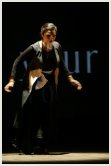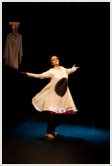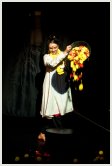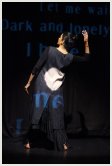 |
 |
 |
 |
 |
 |
 |
 |
 |
|
Home | Credits | Synopsis | Creative Notes | Calendar of Performances | Critics
Speak | Response | Photo Gallery | Bios AVANI.. a handful of dust a dance theatre presentation by Anita Ratnam and ensemble The choreography, music and film design draw inspiration from Tagores's poetry and its inflections, focusing on its nuances and subtleties. Scene: A backyard. A verandah. You. Me. Anyone. Immersed, submerged in the potent beauty of Gurudev's words. Section 1 First Handful - DUST "Clouds heap upon clouds and it darkens. Ah, love, why do you let me wait outside at the door all alone?" (translation from Geetanjali, Poem 18). Longing, Rememberance, Hope. An exploration of the myriad moods of love and its interior landscapes. Themes of longing, separation, memory, loss, pain, hope are extrapolated and abstracted in this piece. Using the abhinaya from the Bharatanatyam traditions and spoken text, the choreography paints new brush strokes as it reconfigures familiar notions of sringara. The choreography also juxtaposes the poetry of Tagore with the uplifting poetry of Tamil poet and social activist Kalki Krishnamoorthy, thus reinforcing Tagore's vision of a pan-Indian aesthetic. Section 2 Second Handful - Words "You make me endless, such is your pleasure" (translation from Geetanjali, Poem 1). Ethereal, Divine, Inseparable. Using the complex rhythms from global percussive influences, the high-energy, movement oriented choreography utilizes adavus from Bharatanatyam in more innovative ways. The choreographic intent is to work against the dreamlike, ethereal, metaphysical poetry, offering a kine-aesthetic counterpoint using cross rhythms and spoken text. The dance-design and music reverberate the entire stage with multiple possibilities of how the self and the divine, the individual and the universe are inseparable. The feminine poetry co-exists with the masculine percussion in this work, reflecting Tagore's concept of polarity and dichotomy. Section 3 Third Handful - Flowers "Bashonti - O Charmer of the Universe" Spring. Colour. Life. "Enchanting Mohini, your eternal beauty mesmerizes the world" (Tagore) "Regal Meenakshi, you are the sole refuge for all of humanity" (Dikshitar) The haunting composition of masterful Carnatic composer Muthuswammi Dikshitar captivated Tagore when he heard it on his visit to Madras. He carried the song back with him to Shantiniketan and transformed the devotional lyric into an iconic song that transposed the Tamil Goddess Meenakshi into an eternally beautiful Basonti / Spring. The overlapping of melodic structures, deeply resonant of quiet meditative spaces reveals the deep wisdom and hypnotic inner landscapes of two geniuses who lived a century apart. Section 4 Fourth Handful - Leaves "O Tree, daughter of the sun, hymn to the light" Magic. Blue. Green A series of writings on trees called "Briksha Bandana" marks Tagore's reverence for the outdoors. His classrooms at Santiniketan were the open skies and the shade of the many magnificent trees that gave shade to his bristling and fecund mind. The choreography plays off the words of the actor and the quiet counterpoint of a single hand gesture that moves, sweeps, evokes, conjures and suggests the many worlds that occur around trees - a silent and static witness to humanity. Section 5 Fifth Handful - Gold "Today at the altar of the day's end, as it blows in a last salutation, I make you my obeisance- accept it, O Earth!" (from Prthivi, translated by Tarak Sen). Nature/Nurture - Chaos, Calm Tagore has created masterful epic poetry, animating the earth as a utopian vessel of purity and excellence, constantly being exploited by mankind. Drawing inspiration from Tagore's vision, this interdisciplinary work uses the earth as a metaphor for the many faces/phases of humanity addressing current concerns of the environmental degradation. The choreography views the earth as a feminine energy and draws inspiration from the rich Goddess mythology of India. Tagore invokes the earth as Usha (dawn), Sandhya (dusk), Annapurna (goddess of abundance), Annakrita (terrible). Recontexualizing these classical tropes of the feminine divine, the choreography further reassesses how these tropes are applicable to the modern 21st century. A combination of contemporary and classical soundscapes, spoken text, the choreography draws upon diverse vocabularies such as Kathakali, Bharatanatyam, Butoh, meditative movement, rehearsed improvisations and theatrical interventions. |